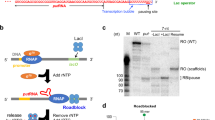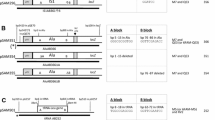Abstract
The upper pathway operon of the Pseudomonas putida TOL plasmid belongs to the −12/-24 class of promoters. These promoters exhibit three regions critical for regulated transcription, namely, the −12/−24 site for RNA polymerase/σ54 binding, the −55/−67 region for IHF protein binding, and the -130(UAS2)/−170(UAS1) region, where two sites for XylR binding are located. The XylR-protected G residues located at −131, −139, −160 and −169 were replaced with As, and the activity of the mutant promoters was assayed after fusion to a promoterless lacZ gene. The mutation (G(−169) → A) resulted in a 50% decrease in expression from the promoter (Pu), whereas the other three changes had no significant effect. The XylR recognition sequence UAS2 has a perfect inverted repeat (5′-ATTTN4 AAAT-3′) while UAS1 shows two mismatches (5′-CCTTN4AAAT - 3′). The two Cs (located at −172 and −173), which interrupt the inverted repeat, were changed as follows: C(−172)→ T; C(−173)→A, CC(−172, −173) −AT. Transcription activation from the mutant promoters was measured as β-galactosidase activity after fusion to lacZ; the better the palindromic sequence, the higher the rate of transcription from Pu, with increases in activity of up to 50%. The introduction of one or two full helix turns between the IHF and the XylR binding sites did not significantly affect transcription from Pu; however, the insertion of three helix turns resulted in a drop of 90% in the activity. The non-permissive effect of insertion of three full helix turns between the IHF and XylR binding sites was not evident in an IHF- background. The introduction of a half helix turn between the RNA polymerase/σ54 and IHF sites also resulted in a notable decrease in transcription from Pu; however, the introduction of one full helix turn did not affect transcription from Pu. The introduction of a full helix turn on both sides of the IHF binding site reduced expression from Pu by 75%, whereas the introduction of a half helix turn on both sides decreased expression by more than 90%. Our findings help to elucidate the sequence requirements for expression from Pit and the architectural organization of the Pu promoter.
Similar content being viewed by others
References
Abril MA, Michán C, Timmis KN, Ramos JL (1989) Regulator and enzyme specificities of the TOL plasmid-encoded upper pathway for degradation of aromatic hydrocarbons and expansion of the substrate range of the pathway. J Bacteriol 171:6782–6790
Abril MA, Buck M, Ramos JL (1991) Activation of the Pseudomonas TOL plasmid upper pathway operon. J Biol Chem 266:15832–15838
Ames GFL, Nikaido K (1985) Nitrogen regulation in Salmonella typhimurium. Identification of a ntrC protein-binding site and definition of a consensus binding sequence. EMBO J 4:539–547
Ausubel FM (1984) Regulation of nitrogen fixation genes. Cell 37:5–6
Biek DP, Cohen SN (1986) Identification and characterization of recD, a gene affecting plasmid maintenance and recombination in Escherichia coli. J Bacteriol 167:594–603
Birkman A, Böck A (1989) Characterization of a cis regulatory DNA element necessary for formate induction of the formate dehydrogenase gene (fdhF) of Escherichia coli. Mol Microbiol 3:187–195
Buck M, Miller S, Drummond M, Dixon R (1986) Upstream activators are present in the promoters of nitrogen fixation genes. Nature 320:374–378
Buck M, Cannon W, Woodcock J (1987) Transcriptional activation of the Klebsiella pneumoniae nitrogenase promoter may involve DNA loop formation. Mol Microbiol 1:243–249
Cannon W, Kreutzer R, Kent HM, Morett E, Buck M (1990) Activation of the Klebsiella pneumoniae nifU promoter: identification of multiple and overlapping upstream NifA binding sites. Nucleic Acids Res 18:1693–1701
Casadaban MJ, Chou J, Cohen SN (1980) In vitro gene fusions that join an enzymatically active β-galactosidase segment to aminoterminal fragments of exogenous proteins: Escherichia coli plasmid vectors for the detection and cloning of translational initiation signals. J Bacteriol 143:971–980
Claverie-Martin F, Magasanik B (1991) Role of integration host factor in the regulation of the glnHp2 promoter of Escherichia coli. Proc Natl Acad Sci USA 88:1631–1635
Dixon R (1984) The genetic complexity of nitrogen fixation. J Gen Microbiol 130:2745–2755
Dixon R (1986) The xylABC promoter from the Pseudomonas putida TOL plasmid is activated by nitrogen regulatory genes in Escherichia coli. Mol Gen Genet 206:129–136
Gober JW, Shapiro L (1990) Integration host factor is required for the activation of developmentally regulated genes in Caulobacter. Genes Dev 4:1494–1504
Goodman SD, Nash HA (1989) Functional replacement of a protein induced bend in a DNA recombination site. Nature 341:251–254
Harayama S, Timmis KN (1989) Catabolism of aromatic hydrocarbons by Pseudomonas. In: Hopwood, DA, Chater KI (eds) Genetics of bacterial diversity. Acdemic Press, London, pp 154–174
Holtel A, Abril MA, Marqués S, Timmis KN, Ramos JL (1990) Promoter-upstream activator sequences are required for expression of the xylS gene and upper-pathway operon on the Pseudomonas TOL plasmid. Mol Microbiol 4:1551–1556
Holtel A, Timmis KN, Ramos JL (1992) Upstream binding sequences of the XyIR activator protein and integration host factor in the xylS gene promoter region of the Pseudomonas TOL plasmid. Nucleic Acids Res 20:1755–1762
Hoover TR, Santero E, Porter S, Kustu S (1990). The integration host factor stimulates interaction of RNA polymerase with NIFA, the transcriptional activator for nitrogen fixation operons. Cell 63:11–22
Huang L, Tsui P, Freundlich M (1990) Integration host factor is a negative effector of in vivo and in vitro expression of ompC in Escherichia coli. J Bacteriol 172:5293–5298
Inouye S, Nakazawa A, Nakazawa T (1983) Molecular cloning of regulatory gene xylR and operator-promoter regions of the xylABC and xylDEGF operon of the TOL plasmid. J Bacteriol 155:1192–1199
Inouye S, Ebina Y, Nakazawa A, Nakazawa T (1984) Nucleotide sequence surrounding transcription initiation site of xylABC operon on TOL plasmid of Pseudomonas putida. Proc Natl Acad Sci USA 81:1688–1691
Inouye S, Nakazawa A, Nakazawa T (1987) Expression of the regulatory gene xylS on the TOL plasmid is positively controlled by the xylR gene product. Proc Natl Acad Sci USA 84:5182–5186
Inouye S, Gomada M, Sangodar UMX, Nakazawa A, Nakazawa T (1990) Upstream regulatory sequence for transcriptional activator XylR in the first operon of xylene metabolism on the TOL plasmid. J Mol Biol 216:251–260
Jiang J, Gu B, Albright LA, Nixon BT (1989) Conservation between coding and regulatory elements of Rhizobium meliloti and Rhizobium leguminosarum dct genes. J Bacteriol 171: 5244–5253
Kunkel TA, Roberts JD, Zakour RA (1987) Rapid and efficient mutagenesis without phenotypic selection. Methods Enzymol 154:367–382
Köhler T, Harayama S, Ramos JL, Timmis KN (1989) Involvement of Pseudomonas putida rpoN sigma factor in regulation of various metabolic functions. J Bacteriol 171:4326–4333
Kustu S, Santero E, Keener J, Popham D, Weiss D (1989) Expression of sigma-54 (ntrA)-dependent genes is probably united by a common mechanism. Microbiol Rev 53:367–376
de Lorenzo V, Herrero M, Metzke M, Timmis KN (1991) An upstream xylR and IHF induced nucleoprotein complex regulates the sigma-54 dependent Pu promoter of TOL plasmid. EMBO J 10:1159–1167
Maniatis TE, Fritsch EF, Sambrook J (1982) Molecular cloning: a laboratory manual. Cold Spring Harbor Laboratory Press, Cold Spring Harbor, New York
Miller JH (1972) Experiments in molecular genetics. Cold Spring Harbor Laboratory Press, Cold Spring Harbor, New York
Mullin DA, Newton A (1989) Ntr-like promoters and upstream regulatory sequence ftr are required for transcription of a developmentally regulated Caulobacter crescentus flagellar gene. J Bacteriol 171:3218–3227
Ninfa AJ, Reitzer LJ, Magasanik B (1987) Initiation of transcription at the bacterial glnAp2 promoter by purified E. coli components is facilitated by enhancers. Cell 50:1039–1046
Popham D, Szeto D, Keener J, Kustu S (1989) Function of a bacterial activator protein that binds to transcriptional enhancers. Science 243:629–635
Prentki P, Krisch HM (1984) In vitro insertional mutagenesis with a selectable DNA fragment. Gene 29:303–313
Ramos JL, Mermod N, Timmis KN (1987) Regulatory circuits controlling transcription of TOL plasmid operon encoding meta-cleavage pathway for degradation of alkylbenzoates by Pseudomonas. Mol Microbiol 1:297–300
Reitzer LJ, Magasanik B (1986) Transcription of glnA in E. coli is stimulated by activator bound to sites far from the promoter. Cell 45:785–792
Santero E, Hoover T, Keener J, Kustu S (1989) In vitro activity of the nitrogen fixation regulatory protein ntrA. Proc Natl Acad Sci USA 86:7346–7350
Sasse-Dwight S, Gralla JD (1988) Probing the Escherichia coli glnALG upstream activation mechanism in vivo Proc Natl Acad Sci USA 85:8934–8938
Snyder UK Thompson JF Landy A (1989) Phasing of proteininduced DNA bends in a recombination complex Nature 341:255–257
Su W Porter S, Kustu S, Echols H (1990) DNA-looping and enhancer activity: association between DNA-bound NtrC activator and RNA polymerase at the bacterial glnA promoter. Proc Natl Acad Sci USA 87:5504–5508
Thompson RJ, Mosig G (1988) Integration host factor (IHF) represses a Chlamydomonas chloroplast promoter in E. coli. Nucleic Acids Res 16:3313–3326
Thöny B, Hennecke H (1989) The −12/−24 promoter comes of age. FEMS Microbiol Rev 63:341–358
Zoller MJ, Smith M (1983) Oligonucleotide-directed mutagenesis of DNA fragments cloned into M13 vectors. Methods Enzymol 100:468–500
Author information
Authors and Affiliations
Additional information
Communicated by H. Hennecke
Rights and permissions
About this article
Cite this article
Abril, M.A., Ramos, J.L. Physical organization of the upper pathway operon promoter of the Pseudomonas TOL plasmid. Sequence and positional requirements for XylR-dependent activation of transcription. Molec. Gen. Genet. 239, 281–288 (1993). https://doi.org/10.1007/BF00281629
Received:
Accepted:
Issue Date:
DOI: https://doi.org/10.1007/BF00281629




